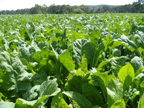
Brassicas
Forage brassica crops such as turnip, swede, rape, and kale can be spring-seeded to supplement the perennial cool-season pastures in August and September or summer-seeded to extend the grazing season in November and December.
Brassicas are annual crops which are highly productive and digestible and can be grazed 80 to 150 days after seeding, depending on the species. In addition, crude protein levels are high, varying from 15 to 25 percent in the herbage and 8 to 15 percent in the roots, depending on the level of nitrogen fertilization and weather conditions.
Kale (Brassica oleracea L.)
Varieties of kale differ markedly in winter hardiness, rate of establishment, stem development, and time required to reach maturity. The stemless type kale (e.g. ‘Premier’) has a faster rate of establishment than varieties which produce stems. Crop height of the stemless type is approximately 25 inches, whereas that of narrow stem kale is 60 inches with primary stems often 2 inches in diameter. Stemless kale attains maturity in approximately 90 days, allowing two crops per year, whereas varieties that develop stems require 150 to 180 days to attain maximum production. ‘Premier’ has consistently survived winters in central Pennsylvania, whereas other varieties of kale usually are winter-killed in December.
Rape (Brassica napus L.)
Mature forage rape is one of the best crops available for fattening lambs and flushing ewes. Rape is a multi-stemmed crop with fibrous roots. The stems vary in length, diameter, and in palatability to livestock. Forage yields of spring-planted rape increase until plants become physiologically mature. Growth slows or ceases at maturity and yields plateau until leaves senesce and die. Varieties differ in when this occurs, however, ‘Rangi’ rape retains its leaves longer than most varieties. Generally, yields of rape varieties in Pennsylvania are maximized with two 90-day growth periods. However, performance of ‘Emerald’ and ‘Winfred’ rape varieties is best with one 180-day growth period, and yields of rape hybrids are greatest with 60 days of growth before the first harvest and a 30-day growth period before the second harvest.
Swede (Brassica napus L.)
Like turnip, swede produces a large edible root. Swede yields are higher than those of turnip, although growth is slower and requires 150 to 180 days to reach maximum production. Swede usually produces a short stem (neck), but can have stems 2½ feet long when grown with tall crops which shade the swede. Unfortunately, stem elongation is at the expense of root development. The variety ‘Calder’ is cold hardy in central Pennsylvania and thus ideal for stockpiling and for late fall or early winter grazing. In general, all swede varieties are recommended for late fall grazing.
Turnip (Brassica rapa L.) or Turnip hybrids
These crops grow very fast, reaching near maximum production levels in 80 to 90 days. Studies in southwestern Pennsylvania showed that turnip can accumulate dry matter in October as fast as field corn does in August. Growing “out of season” (October/November) makes turnip a valuable crop for late fall grazing.
The proportions of tops and roots varies markedly depending on variety, crop age, and planting date. Research by the USDA Pasture Laboratory showed that turnip crops can vary from 90 percent tops/10 percent roots to 15 percent tops/85 percent roots. Some hybrids have fibrous roots which will not be readily grazed by livestock. All varieties produce primarily tops during the first 45 days of growth. Sixty to 90 days after seeding, turnip varieties such as ‘Savannah’ and ‘All Top’ continue to produce a high proportion of tops. During the same period, other turnip varieties have nearly equal top and root production, except ‘Purple Top’ has a greater root than top production. The significance in the proportion of tops and roots is that the crude protein concentration (8 to 10%) of roots is approximately one-half of that in turnip tops. Therefore, greater root production tends to reduce the crude protein yield of the total crop. On the other hand, stockpiled tops appear to be more vulnerable to weather and pest damage than roots. Varieties differ in their resistance to diseases, but this often is not evident until the crop is more than 80 days of age and the plants are reaching full production.
Planting Guides And Seed Information
For more information about seeds and planting, please consult the following guides and information sheets.
Green Manure and Cover Crops
Cover Crop Planting Specification Guide
Forage Planting Guide
Turf Planting Guide
 North Country Organics
North Country Organics